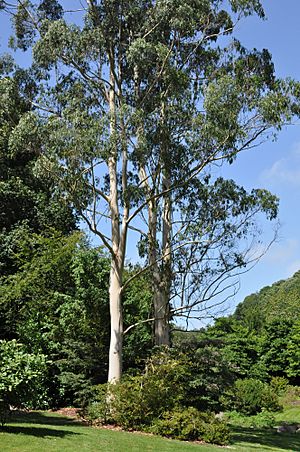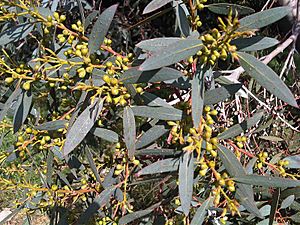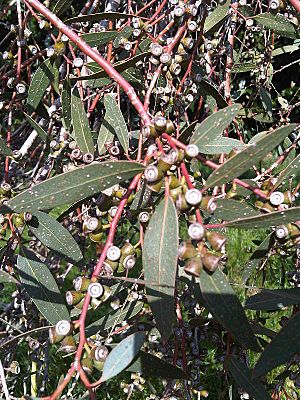Mountain gum facts for kids
Quick facts for kids Mountain gum |
|
|---|---|
 |
|
| Eucalyptus dalrympleana in a botanical garden in Brest, France | |
| Scientific classification | |
| Genus: |
Eucalyptus
|
| Species: |
dalrympleana
|
The Mountain Gum (Eucalyptus dalrympleana) is a tall tree found only in southeastern Australia. It's also known as mountain white gum, white gum, or broad-leaved ribbon gum. This tree has smooth bark, long, thin adult leaves, and pretty white flowers. Its fruit looks like small cups or bells.
Contents
What the Mountain Gum Looks Like
The Mountain Gum is a tree that can grow very tall, sometimes up to 40 meters (about 130 feet) high. It has smooth bark that can be white or yellowish. Sometimes, the bottom part of the trunk has rough bark.
Young Mountain Gum plants have leaves that are shaped like eggs or hearts. These leaves are arranged in pairs opposite each other on the stem. They are about 2.5 to 7 centimeters (1 to 2.7 inches) long and wide.
As the tree gets older, its leaves change. Adult leaves are long and narrow, like a spearhead. They are the same color on both sides and are about 8 to 22 centimeters (3 to 8.6 inches) long. These leaves grow on a small stem called a petiole, which is about 1.2 to 3.5 centimeters (0.5 to 1.4 inches) long.
The flower buds grow in groups of three or seven. They appear where the leaves meet the stem. Each group of buds sits on a small stalk called a peduncle, which is 3 to 12 millimeters long. The buds themselves are oval-shaped and can be green or yellow. They are 6 to 10 millimeters long. Each bud has a cap, called an operculum, which is cone-shaped or rounded.
Mountain Gums usually flower between March and June. Their flowers are white and beautiful. After flowering, the tree produces woody fruits. These fruits are shaped like cups, bells, or half-spheres. They are about 3 to 8 millimeters long and 5 to 9 millimeters wide.
How It Got Its Name
The Mountain Gum was first officially described in 1920 by a botanist named Joseph Maiden. He studied a sample of the tree found near Yarrangobilly. Maiden published his description in a book called The Forest Flora of New South Wales.
The second part of the tree's scientific name, dalrympleana, was chosen to honor Richard Dalrymple Hay. He was a forester, someone who manages forests.
In 1962, another scientist, Lawrie Johnson, identified two slightly different types of Mountain Gum. These are called subspecies:
- Eucalyptus dalrympleana subsp. dalrympleana: This type has flower buds that grow in groups of three.
- Eucalyptus dalrympleana subsp. heptantha: This type has flower buds and flowers that grow in groups of seven.
Where Mountain Gums Live
Mountain Gums grow in forests and woodlands in higher areas of southeastern Australia. You can find them in parts of Queensland, New South Wales, Victoria, South Australia, and Tasmania.
The subspecies heptantha is found only in far southeastern Queensland and the northern parts of New South Wales. The subspecies dalrympleana grows further south, from the central and southern parts of New South Wales. In South Australia, the Mountain Gum is quite rare and only grows in the Mount Lofty Ranges.
Growing Mountain Gums in Gardens
People sometimes grow Mountain Gums in gardens, especially in places like the UK. These trees are very tough and can survive cold temperatures, even down to -15 degrees Celsius (5 degrees Fahrenheit). However, they prefer a bit of shelter from strong winds. They grow best in sunny spots.
The Mountain Gum has even won an award called the Royal Horticultural Society's Award of Garden Merit. This award means it's a great plant for gardens.
Further Reading
- Holliday, I. A field guide to Australian trees (3rd edition), Reed New Holland, 2002



